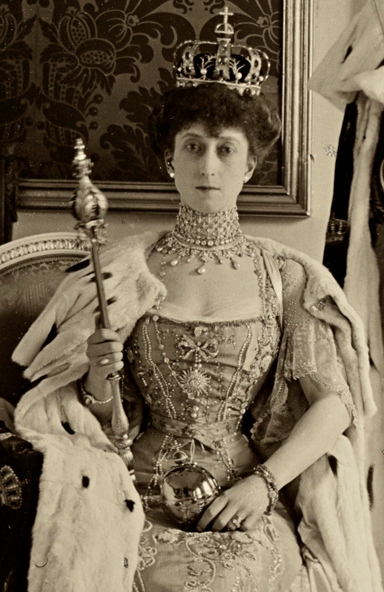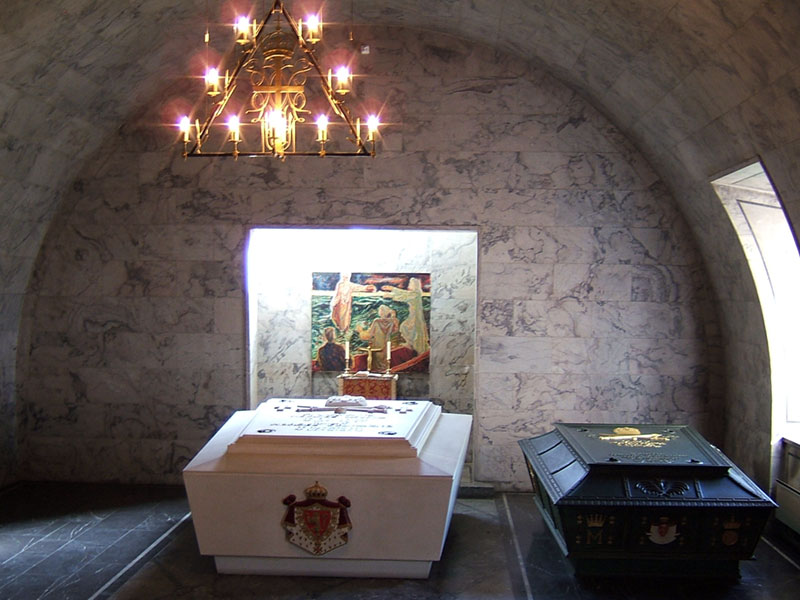by An Ard Ri and Susan Flantzer © Unofficial Royalty 2012
All photos are from Wikipedia unless otherwise noted.
In 1905, upon the dissolution of the Union between Sweden and Norway, the Norwegian government began searching for candidates to become King of Norway. Because of his descent from prior Norwegian monarchs, as well as his wife’s British connections, Prince Carl of Denmark, the second son of King Frederik VIII of Denmark, was the overwhelming favorite. Before accepting, Carl insisted that the voices of the Norwegian people be heard in regards to retaining a monarchy. Following a referendum with a 79% majority in favor, Prince Carl was formally offered and then accepted the throne. He sailed for Norway, arriving on November 25, 1905, and took the oath as King two days later. He took the name Haakon VII and his two-year-old son was renamed Olav and became Crown Prince of Norway and later reigned as King Olav V.
Akershus Fortress is a medieval castle that was built to protect the city of Oslo and has also been used as a prison. Construction of the fortress started in the 1290s by King Haakon V. Today, it is the site of the headquarters of the Norwegian Ministry of Defense and Defense Staff Norway. Also within the walls of the Akershus Fortress is the Royal Mausoleum designed by Norwegian architect Arnstein Rynning Arneberg and completed in 1948.

The Royal Mausoleum at Akershus Fortress
With few exceptions, burial sites and/or remains of Norwegian monarchs before 1380 have disappeared. Nearly all Norwegian monarchs between 1380 and 1905 are buried in other countries. During this time period, Norwegian monarchs were also monarchs of Denmark and/or Sweden and were buried at Roskilde Cathedral in Roskilde, Denmark; Riddarholmen Church in Stockholm, Sweden; St. Peter’s Cathedral in Schleswig, Germany; and St. Mary’s Church in Darłowo, Poland. The remains of King Sigurd I (circa 1090–1130), King Haakon V (1270–1319) and his second wife Queen Euphemia (1270–1312), were transferred from their original burial places in Oslo to the Royal Mausoleum.
Gravemarker of King Haakon V and Queen Euphemia
The members of the Norwegian royal family belong to the Church of Norway, an evangelical Lutheran denomination of Protestant Christianity. Until a constitutional amendment in 2012, the monarch was the supreme governor and protector of the Church of Norway. Since 2012, the Church of Norway has been self-governing but it remains the established state church.
House of Schleswig-Holstein-Sonderburg-Glücksburg (1905 – present)
- Haakon VII (reigned November 18, 1905 – September 21, 1957)
- Olav V (reigned September 21, 1957 – January 17, 1991)
- Harald V (reigned January 17, 1991 – present)
Unofficial Royalty: Norwegian Index
Official Website of the Royal House of Norway
********************
Haakon VII, King of Norway
Reigned 18 November 18, 1905 – September 21, 1957

Haakon VII was born Prince Carl of Denmark on August 3, 1872, at Charlottenlund Palace near Copenhagen. He was the second son of the future King Frederick VIII of Denmark and his wife Louise of Sweden. In July 1896, he married his first cousin, Princess Maud of Wales, at Buckingham Palace. The couple had one child, Olav V, who succeeded his father. In 1905, following the Dissolution of the Union between Sweden and Norway, Carl was elected King of Norway and took the Old Norse name Haakon, a name used by previous Kings of Norway. He reigned as King Haakon VII for nearly 52 years.
Haakon VII died at the Royal Palace, Oslo on September 21, 1957, at the age of 85 and was buried with his wife Maud in the white sarcophagus at the Royal Mausoleum in the Akershus Fortress, Oslo.
********************
Maud of Wales, Queen of Norway

Maud was born on November 26, 1869, at Marlborough House, London, and was the youngest child of Albert Edward, Prince of Wales (the future Edward VII) and Alexandra of Denmark. She married the future Haakon VII of Norway in 1896 and was the mother of Olav V.
Queen Maud died of heart failure three days after surgery in London on November 20, 1938, at age 68. Her remains were returned to Norway and were buried at the Royal Mausoleum in the Akershus Fortress, Oslo.
********************
Olav, V, King of Norway
Reigned September 21, 1957 – January 17, 1991

Olav V was born on July 2, 1903, at Appleton House on the Sandringham Estate in Norfolk, the United Kingdom to Prince Carl of Denmark and Princess Maud of Wales. At birth, he was Prince Alexander Edward Christian Frederik of Denmark. In 1905, when his father was elected King of Norway, his name was changed to Olav. In March 1929, he married his first cousin Princess Märtha of Sweden. The couple had three children, a son, Harald V who succeeded his father, and two daughters, Ragnhild and Astrid. Olav became King of Norway upon the death of his father in September 1957.
King Olav V died of a heart attack at the age of 87 on January 17, 1991. He is buried with his wife Märtha in the green sarcophagus in the Royal Mausoleum at Akershus Fortress.
********************
Princess Märtha of Sweden, Crown Princess of Norway

Princess Märtha of Sweden was born in Stockholm on March 28, 1901, and was the daughter of Prince Carl of Sweden and Princess Ingeborg of Denmark. She married the future Olav V in September 1929.
At the age of 53, the Crown Princess died of cancer on April 5, 1954, in Oslo and was buried at the Royal Mausoleum in the Akershus Fortress, Oslo.
********************
This article is the intellectual property of Unofficial Royalty and is NOT TO BE COPIED, EDITED, OR POSTED IN ANY FORM ON ANOTHER WEBSITE under any circumstances. It is permissible to use a link that directs to Unofficial Royalty.



